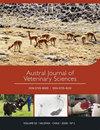濒危野猫脂肪组织间充质干细胞的分化及多能性
IF 0.8
4区 农林科学
Q3 VETERINARY SCIENCES
引用次数: 4
摘要
脂肪源性间充质干细胞(AMSCs)已被分离出来并用于家猫的细胞治疗。对于野猫,仅在黑足猫(Felis nigripes)中报道了AMSCs。猫AMSCs可用于治疗圈养濒危猫的损伤,改进克隆技术或用于诱导多能干细胞(iPSC)的衍生。狮子猫(Leopardus guigna)是智利和阿根廷的一种地方性濒危猫科动物。本研究的目的是根据其主要生物学特性(如生长动力学、分化能力和表面标记物表达)来表征来自木质素的推定AMSCs。将结果与cat AMSCs进行比较。从母猫腹膜脂肪组织和母豚鼠皮下组织中分离出AMSCs。细胞分离培养于DMEM/F12中,添加10% DMEM/F12 + FBS。评估迁移潜力、菌落形成单位测定、中胚层分化和表面标志物表达(CD45、CD44、CD90、MHCI和MHCII)。Â Cat和guigna AMSCs在培养中表现出相似的生长特性。两种AMSCs均表现出中胚层分化潜能;体外归巢电位及相似表面标记的表达。这些结果表明,从木犀草皮下组织中提取的AMSCs可用于该物种的再生治疗,并可考虑用于该野猫的克隆。本文章由计算机程序翻译,如有差异,请以英文原文为准。
Differentiation and multipotential characteristics of mesenchymal stem cells derived from adipose tissue of an endangered wild cat (Leopardus guigna)
Adipose derived mesenchymal stem cells (AMSCs) have been isolated and used as cell therapy in domestic cats. For wild cats, AMSCs have been reported only in black-footed cats (Felis nigripes). Feline AMSCs may be useful to treat the injuries of endangered cats in captivity and to improve cloning techniques or for derivation of induced pluripotent stem cells (iPSC). The guigna (Leopardus guigna) is an endemic and endangered feline from Chile and Argentina. The objective of this study was to characterize putative AMSCs from guigna in terms of their main biological attributes such as: growth kinetics, differentiation ability, and surface marker expression. The results were compared with cat AMSCs. AMSCs were isolated from peritoneal adipose tissue of female cats and subcutaneous tissue from a female guigna. Cells were isolated and cultured in DMEM/F12, supplemented with DMEM/F12 + FBS 10%. Migration potential, Colony-forming unit assay, mesodermal differentiation and surface marker expression (CD45, CD44, CD90, MHCI, and MHCII) were evaluated. Cat and guigna AMSCs displayed similar growth properties in culture. Both AMSCs showed mesodermal differentiation potential; in vitro homing potential and similar surface marker expression. These results demonstrate that the AMSCs from subcutaneous tissue of guigna could potentially be useful in regenerative therapy in this species and could be considered for use in cloning of this wild cat.
求助全文
通过发布文献求助,成功后即可免费获取论文全文。
去求助
来源期刊

Austral Journal of Veterinary Sciences
Veterinary-General Veterinary
CiteScore
1.60
自引率
0.00%
发文量
18
期刊介绍:
Austral Journal of Veterinary Sciences (formerly Archivos de Medicina Veterinaria) publishes original scientific contributions in English, containing the latest developments and discoveries in veterinary sciences. The journal covers topics such as animal health and production, preventive medicine, zoonosis, pharmacology and therapeutics, methods of diagnosis, and other areas related to the veterinary field.
Austral Journal of Veterinary Sciences aims to divulge information about advances in veterinary medicine among universities, research centres, industries, government agencies, biologists, agronomists and veterinarians.
 求助内容:
求助内容: 应助结果提醒方式:
应助结果提醒方式:


